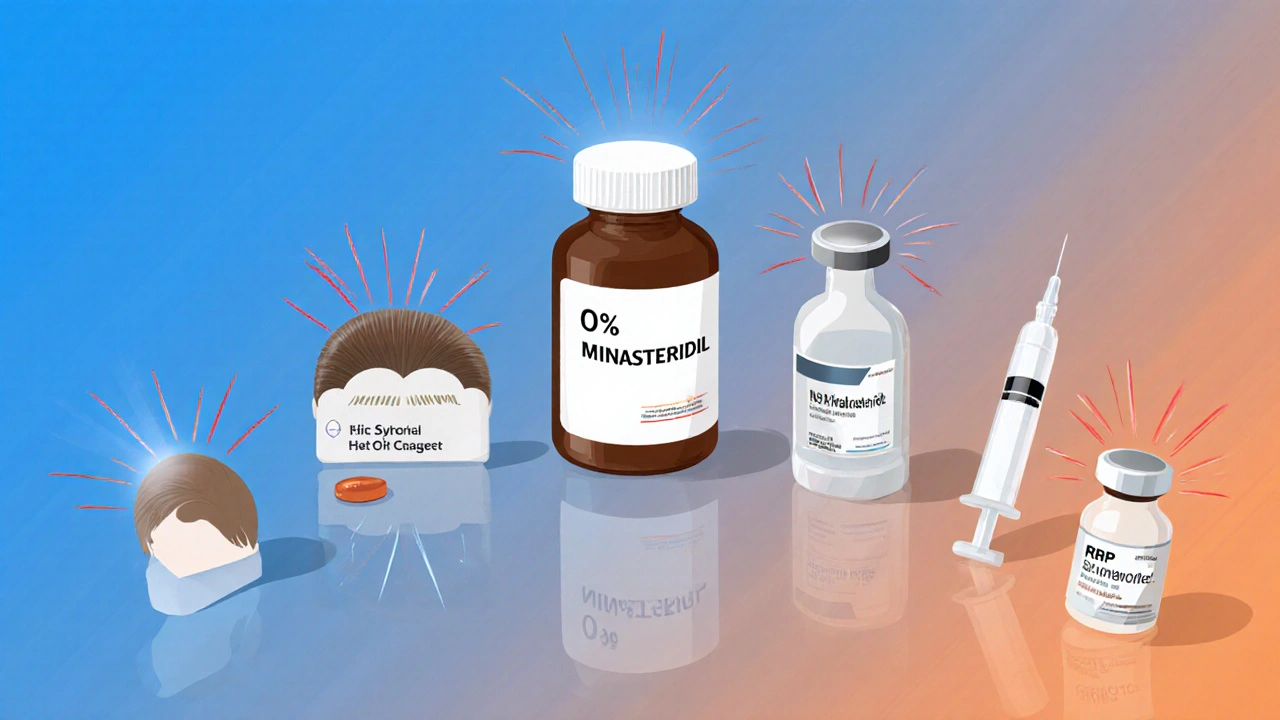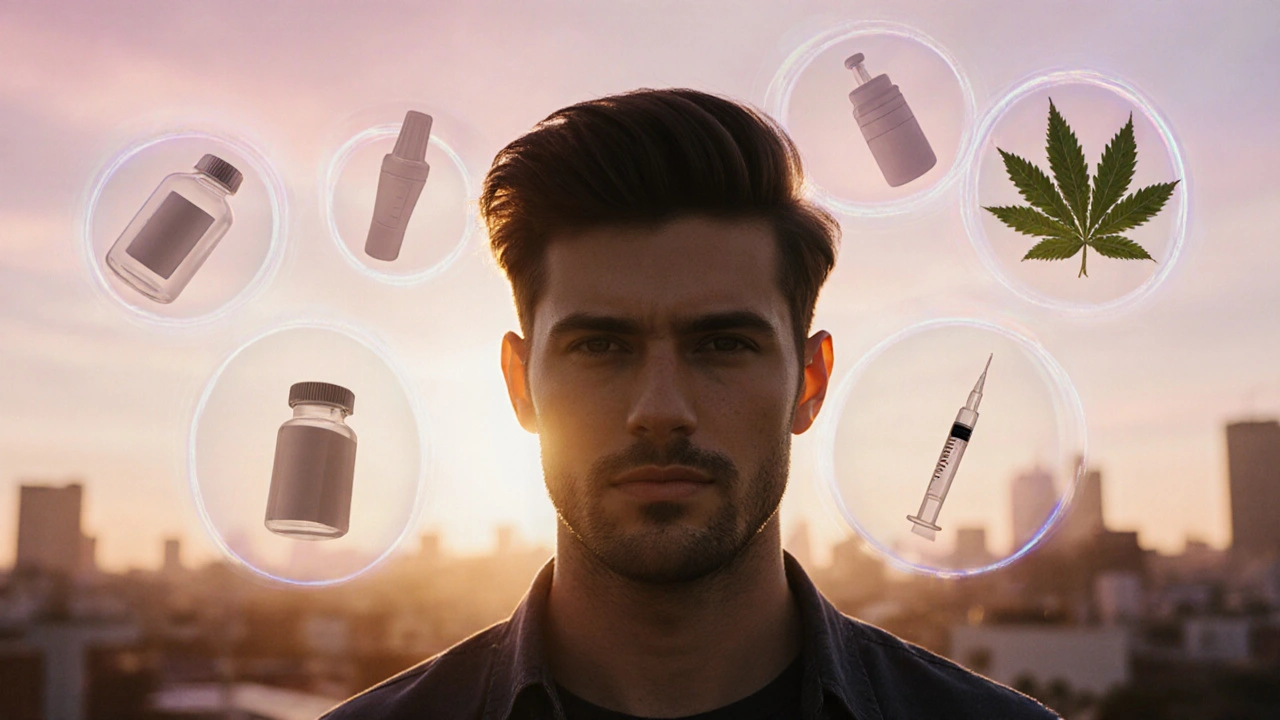Hair Loss Treatment Comparison Tool
Use this tool to compare different hair loss treatments based on your goals, budget, and preferences.
Quick Takeaways
- Finasteride blocks DHT production and is the most proven oral drug for male‑pattern baldness.
- Minoxidil works on the scalp surface, is available over‑the‑counter, and suits both men and women.
- Dutasteride is a stronger DHT blocker but requires a prescription and carries a higher side‑effect load.
- Natural extracts such as saw palmetto and pumpkin seed oil have modest benefits and virtually no adverse effects.
- Procedures like low‑level laser therapy, PRP injections, and hair‑transplant surgery are effective but cost significantly more.
If you’re scrolling through endless forums trying to decide whether to stick with Finasteride or try something else, this guide lays out the science, the costs, and the real‑world outcomes you need to know.
What Is Finasteride (Fincar) and How Does It Work?
Finasteride is a synthetic 5‑alpha‑reductase inhibitor that reduces the conversion of testosterone into dihydrotestosterone (DHT). DHT is the hormone that shrinks hair follicles in androgenetic alopecia (male‑pattern baldness). By lowering scalp DHT levels by roughly 70% after three months, Finasteride slows hair‑line recession and can even regrow thin patches. The brand name Fincar is the UK‑market version marketed for hair loss. Most men start at 1mg per day, and noticeable results typically appear after 6-12months of consistent use.
Major Alternatives at a Glance
Below are the six most common approaches that people stack with, replace, or supplement Finasteride.
Minoxidil is an FDA‑approved topical vasodilator originally developed for hypertension. Applied to the scalp at 2% (women) or 5% (men) concentrations, it prolongs the anagen (growth) phase of hair follicles, increasing shaft thickness by 10‑20% on average.
Dutasteride is another 5‑alpha‑reductase inhibitor, but it blocks both typeI and typeII enzymes, achieving up to a 90% DHT reduction. It is prescribed for enlarged prostate in the UK, yet dermatologists sometimes use it off‑label for severe hair loss.
Saw Palmetto is a plant extract that weakly inhibits 5‑alpha‑reductase and may lower DHT levels by 10‑15% in some users. It is sold as a capsule or softgel, often marketed as a “natural finasteride.”
Pumpkin Seed Oil contains phytosterols that modestly suppress DHT production. Clinical trials in men with androgenetic alopecia showed a 40% improvement in hair density after 24weeks when taken at 400mg daily.
Low‑Level Laser Therapy (LLLT) uses red‑light wavelengths (630‑660nm) to stimulate cellular metabolism in hair follicles. Home‑use laser caps or combs are FDA‑cleared for both genders; results usually appear after 12‑16weeks of thrice‑weekly sessions.
Platelet‑Rich Plasma (PRP) Therapy involves drawing a small amount of the patient’s blood, concentrating platelets, and injecting the plasma into the scalp. Growth factors released from platelets promote follicle rejuvenation. A typical protocol consists of three sessions spaced one month apart, followed by maintenance every 6‑12months.
Hair‑Transplant Surgery permanently relocates healthy follicles from the occipital scalp to balding areas. Techniques such as Follicular Unit Extraction (FUE) achieve natural‑looking density, but the upfront cost runs between £3,000 and £10,000 in the UK.
Side‑Effect Profile - What to Expect
Understanding side effects helps you weigh risk versus reward.
- Finasteride: sexual dysfunction (decreased libido, erectile issues) in ~2% of users, occasional mood changes, and rare prostate‑specific antigen (PSA) alterations.
- Minoxidil: scalp irritation, itching, and rare allergic dermatitis. Systemic absorption is minimal, so systemic side effects are uncommon.
- Dutasteride: higher incidence of sexual side effects (up to 5%) and possible breast tenderness. Because it blocks both enzyme types, it also lowers serum testosterone slightly.
- Saw Palmetto & Pumpkin Seed Oil: virtually none; occasional gastrointestinal upset.
- LLLT: no reported systemic effects; mild scalp warmth or tingling.
- PRP: temporary redness, swelling, or bruising at injection sites; rare infection.
- Hair‑Transplant: post‑op soreness, scabbing, and rare graft loss.

Cost Comparison (2025 UK Prices)
| Treatment | Typical Annual Cost | Prescription Needed? | Convenience | Average Efficacy |
|---|---|---|---|---|
| Finasteride (Fincar) | £30‑£50 | Yes (GP or dermatologist) | Oral pill, daily | High (70‑80% maintain hair) |
| Minoxidil (5%) | £120‑£180 | No | Topical, twice daily | Moderate (30‑40% noticeable regrowth) |
| Dutasteride | £80‑£120 | Yes | Oral pill, daily | Very High (80‑90% maintain hair) |
| Saw Palmetto | £25‑£40 | No | Oral capsule, daily | Low‑Moderate (10‑15% DHT reduction) |
| Pumpkin Seed Oil | £30‑£55 | No | Oral capsule, daily | Low‑Moderate (40% density boost in trials) |
| LLLT Device (cap) | £250‑£500 (one‑time) | No | 3‑4min, 3×/week | Moderate (15‑25% increase in thickness) |
| PRP Therapy | £600‑£900 (initial series) | Yes (clinic visit) | In‑office injections | Moderate‑High (30‑45% improvement) |
| Hair‑Transplant (FUE) | £3,000‑£10,000 (one‑off) | Yes (specialist) | Surgical, recovery 1‑2weeks | Very High (permanent, 80‑100% coverage) |
Choosing the Right Option for You
There’s no one‑size‑fits‑all answer, but you can narrow it down by answering three quick questions:
- What’s your primary goal? Preserve existing hair, regrow a bald spot, or achieve a dense look?
- How much are you willing to spend annually? Low (<£200), medium (£200‑£800), or high (over £800).
- Are you comfortable taking a prescription drug? If not, focus on OTC, natural, or procedural routes.
Based on typical responses:
- Goal = preserve, budget low, open to prescription: Finasteride is the most cost‑effective, backed‑by‑data choice.
- Goal = add volume, budget medium, avoid pills: Combine Minoxidil with a natural extract (saw palmetto) and add LLLT for a multi‑modal boost.
- Goal = dramatic regrowth, budget high, okay with surgery: Consider a hair‑transplant or a series of PRP sessions, possibly after stabilizing DHT with Finasteride or Dutasteride.
Practical Tips for Starting Finasteride or Any Alternative
- Get a baseline blood test. Check testosterone, DHT, and PSA levels before you begin.
- Consult a GP or dermatologist. In the UK, a Prescription Item Form (PIS) is needed for Finasteride and Dutasteride.
- Start with a low‑dose trial. For Finasteride, 1mg daily is standard; if you experience sexual side effects, discuss dose reduction or a switch to Dutasteride.
- Track progress. Take monthly photos, note any shedding, and use a hair‑density app to quantify change.
- Combine wisely. If you add Minoxidil, apply it to a dry scalp at least 30minutes after taking oral medication to avoid dilution.
- Schedule follow‑up labs at 6months. Re‑check DHT and PSA to confirm the drug is acting as expected.
Potential Pitfalls and How to Avoid Them
- Stopping abruptly: Hair loss can rebound within weeks. Taper off under medical supervision.
- Skipping the maintenance phase: Even after regrowth, continue the chosen treatment to keep results.
- Self‑medicating with unverified supplements: Choose clinically tested extracts (e.g., standardized saw palmetto 320mg).
- Expecting instant miracles: Finasteride typically needs 6‑12months; other methods have similar timelines.
Frequently Asked Questions
Can women use Finasteride for hair loss?
Finasteride is not approved for women, especially those of child‑bearing age, because it can cause birth defects. Post‑menopausal women sometimes use it off‑label, but the risk‑benefit ratio is unclear. Women usually start with Minoxidil or low‑dose oral anti‑androgens like spironolactone.
How long does it take to see results with Finasteride?
Most users notice a slowdown in shedding within 3months and measurable regrowth after 6‑12months. Patience is key; stopping early resets the DHT‑reduction effect.
Is it safe to combine Finasteride with Minoxidil?
Yes, the two work via different mechanisms-Finasteride blocks DHT formation, while Minoxidil stimulates follicle growth. Many dermatologists prescribe the combo for faster, more robust results.
What are the main differences between Finasteride and Dutasteride?
Finasteride inhibits only typeII 5‑alpha‑reductase, cutting DHT by ~70%. Dutasteride blocks both typeI and typeII enzymes, achieving up to 90% reduction. The higher potency can translate to slightly better hair‑preservation, but it also raises the odds of sexual side effects.
Are natural supplements like Saw Palmetto enough on their own?
On their own they usually provide modest DHT reduction and may help maintain existing hair, but they rarely trigger noticeable regrowth. Pairing them with Minoxidil or a low‑dose prescription drug yields better outcomes.
How does Low‑Level Laser Therapy compare to medication?
LLLT promotes cellular energy (ATP) in follicles, leading to thicker strands. Its efficacy is comparable to Minoxidil for early‑stage loss, but it doesn’t affect DHT. It’s an excellent adjunct, especially for those wary of drugs.
Is PRP a permanent solution?
PRP stimulates natural growth cycles but the results fade over time. Maintenance sessions every 6-12months are typical to keep the density gains.

Next Steps
Grab a notebook, write down your budget, desired outcome, and comfort level with prescriptions. Then schedule a quick phone call with your GP or a local dermatologist. Bring your notes-they’ll help the clinician recommend the most suitable regimen, whether that’s a simple finasteride script or a multi‑modal plan that combines topical, oral, and procedural options.
Remember, hair loss is a gradual process. Starting early gives you the best chance to preserve what you have and, if needed, add new growth. Choose the path that matches your lifestyle, and stick with it long enough to see real change.

Halle Redick
October 3, 2025 AT 17:23If you're staring at that comparison table and feeling overwhelmed, you're not alone. Hair loss can feel like a personal crisis, but it's really just a set of choices you can manage. Finasteride has built a solid reputation because the science backs its DHT‑blocking power. That said, it's not a one‑size‑fits‑all solution, especially if you worry about sexual side effects. Many folks find that pairing a low dose of Finasteride with a gentle topical like Minoxidil gives a nice synergy. The topical works on the scalp surface while the oral pill tackles the hormone cascade from the inside. If your budget is tight, the natural options like Saw Palmetto or Pumpkin Seed Oil can be a decent starter. They won’t replace a prescription drug, but they add a modest boost with virtually no side effects. For those who love tech, a low‑level laser cap is a painless way to increase follicle activity. Just remember that the results are gradual and you need consistency week after week. If you can swing a bit more cash, PRP injections or even a hair‑transplant give the biggest payoff. PRP is a good middle ground because it uses your own blood and avoids permanent surgery. A transplant, on the other hand, is a one‑time investment that can look completely natural for decades. Whichever path you choose, keep tracking your progress with photos so you can see the subtle improvements. Stay patient, stay positive, and remember that many people have walked this road and come out looking great.
Erica Harrington
October 3, 2025 AT 17:29Looking at the table, the first thing to ask yourself is what you value most: convenience, cost, or maximum regrowth. If daily pills sound manageable, Finasteride or Dutasteride are solid bases. Topical Minoxidil adds a nice boost if you don’t mind the twice‑daily routine. For a budget‑friendly start, give Saw Palmetto a try and see if you notice any change before committing to a prescription. Remember to keep an eye on any scalp irritation or mood shifts – they’re early clues. Pairing low‑cost natural supplements with a good shampoo can help keep the skin healthy. And if you ever feel stuck, a quick photo log over a few months will reveal trends you might miss day‑to‑day. Stay curious, stay consistent, and you’ll find the mix that works for you.
Patricia Mombourquette
October 3, 2025 AT 17:37Finasteride works but side effects can be a real problem.
karl lewis
October 3, 2025 AT 17:45From a scholarly perspective, the data on Finasteride's efficacy is robust, yet one must weigh the ethical considerations of pharmaceutical intervention. The prevalence of sexual dysfunction, albeit modest, raises questions about informed consent. Moreover, the long‑term hormonal impacts remain insufficiently explored. It would be prudent for clinicians to adopt a shared decision‑making model, ensuring patients are fully apprised of potential outcomes. Nonetheless, the drug remains a cornerstone in the therapeutic arsenal. :)
Amy Martinez
October 3, 2025 AT 17:51Hey there, I totally get how confusing the options can feel – it’s like a rabbit hole of pills, serums, and shiny gadgets. One thing I’ve learned is to treat your scalp like a garden: you need consistent watering (that's your daily routine) and the right nutrients (the right treatment). If you’re nervous about prescription meds, start with a gentle natural supplement like pumpkin seed oil and watch how your hair responds. Pair that with a good sulfate‑free shampoo and you’ll keep the environment healthy for growth. And don’t underestimate the power of a good night’s sleep – hormone balance is tied to rest. Keep a weekly photo diary; seeing tiny improvements can boost your motivation big time. You’ve got this, and the right combo is out there waiting for you.
Josh Grabenstein
October 3, 2025 AT 18:01Ever wonder why the pharma giants push Finasteride so hard? It’s not just about hair, it’s about data control. They collect endless usage stats, then market that "science" back to you. Meanwhile, consumer‑grade lasers and natural extracts sit on the shelves, ignored. Some say it’s a coincidence, I say it’s systemic. Stay vigilant, ask who profits – it matters. :)
Marilyn Decalo
October 3, 2025 AT 18:08drama alert! The battle between pills and potions is basically the saga of modern vanity. On one side you have the sterile, prescription‑driven Finasteride, promising near‑miraculous results but whispering about libido losses. On the other, the wild, earthy Saw Palmetto, claiming to be the “natural hero” while barely moving the needle. Then there’s the laser cap, the futuristic gadget that looks like something out of a sci‑fi movie, promising a 20% boost that might just be placebo. And don’t forget PRP, the bloody needle ceremony that sounds both avant‑garde and terrifying. The truth? It’s a mosaic, not a monolith, and each piece fits a different puzzle. So pick your piece, own the drama, and watch the hair grow.
Mary Louise Leonardo
October 3, 2025 AT 18:16Finasteride? More like a secret experiment. They don’t want you to know how it changes brain chemistry.
Alex Bennett
October 3, 2025 AT 18:21Ah, the classic “just take the pill” mantra – so delightfully simple, yet completely ignoring the nuanced biology at play. One might argue that relying solely on a 5‑alpha‑reductase inhibitor is like using a single brush to paint an entire masterpiece; you’ll miss the subtle shades. It’s refreshing to see people experiment with light therapy; the red wavelengths actually stimulate mitochondrial function in follicles. Still, the notion that a laser cap can replace a surgical transplant is, frankly, a bit far‑fetched. Keep a balanced regimen, stay skeptical of hype, and let the data guide you.
Mica Massenburg
October 3, 2025 AT 18:30Listen, the whole discussion about PRP being "safe" is a cover‑up. Those clinics are just money‑making factories, and the red‑light devices? Probably just a glow‑in‑the‑dark gimmick. You should question why we never see independent studies that aren’t sponsored. It’s all part of the larger agenda to keep us dependent on their products.
Sarah Brown
October 3, 2025 AT 18:42Enough with the half‑baked theories – let’s get real. If you’re serious about a solution, start with a proper medical evaluation, not conspiracy blogs. Choose a treatment backed by peer‑reviewed studies, whether it’s Finasteride, Dutasteride, or a transplant, and stick to a disciplined routine. Stop feeding the rumor mill and invest in evidence; your hair (and sanity) will thank you.